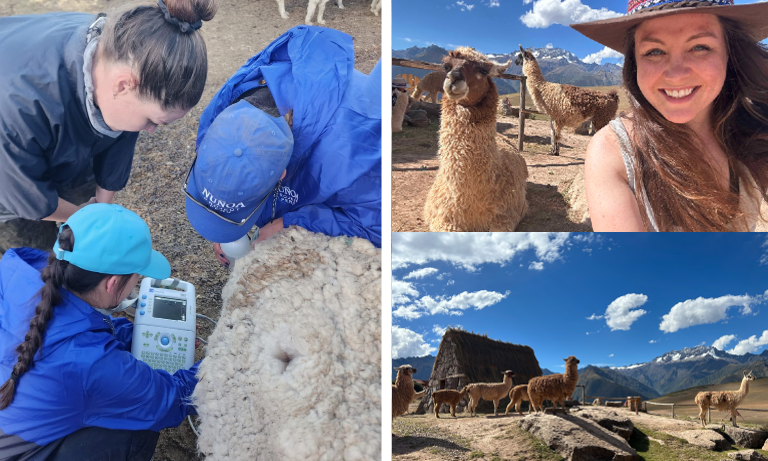Standing up for the veterinary profession
08 Aug 2024
13 Jun 2024 | Ami Sawran
With camelid numbers rising, Ami Sawran, Clinical Director of Westpoint Farm Vets, is keen to inspire confidence among vets who may have these animals in their caseload.

I never expected my career pathway to be so entrenched in the health and welfare of animals that I'd never learned about at university. So much so, that before first attending an alpaca, I had to google them. I had to learn very quickly that they were not a charming mix of sheep and giraffes – instead very much their own entity with unique characters, physiology, and husbandry needs.
Luckily, my boss had a penchant for our fluffy South American friends, and a crash course in handling huacayas began. I was lucky to have a mentor that was enthusiastic about camelid care – I know many are not this fortunate, and I think this contributes hugely to the unease many practitioners describe when tending to camelids. Universities are gradually realising the importance of camelid teaching – with an estimated 60,000 alpacas and 5,000 llamas in the UK needing standardised veterinary care.
Whose case is it anyway?
Camelids appear to have fallen down the crack in the veterinary sofa. Farm practitioners didn't always recognise them as livestock, feeling they’re best catered to by equine vets. Equine vets are indeed equipped to deal with intensive neonatal care, for example, but camelid susceptibility to many common diseases of livestock means that herd health is ably catered to by farm vets. I appreciate that we are all used to delivering a good standard of care to our usual patients, so it can be disquieting to deal with unfamiliar species where you might not be able to. There has also been a possible lack of appreciation of the value of camelid work to farm businesses. Camelids can bolster traditionally quieter seasons with unpacking season over summer. Regardless of reasoning, it is apparent that camelid work can be stacked upon new graduates who have reasonable feelings of anxiety.
Camelid owners can often find themselves in frustrating positions. With no medicines licenced for camelids, they cannot utilise a Suitably Qualified Persons (SQPs). This means veterinary involvement is essential in health planning and prescribing – positive for camelid welfare, if we endeavour to learn more.
There are also legal reasons why veterinary investment in camelid husbandry is essential. They sometimes need remedial dentistry that only vets can perform. To uphold the law and animal welfare, we must upskill to meet this need, or at least know where to refer to.
I can speak from experience that the work is very rewarding for those who enjoy individual animal workups as well as herd-level health planning. When undertaking my CertAVP, I found myself improving as a cattle and sheep vet too.
When delivering camelid CPD, I usually begin by playing a word association game – ‘What do you think when a camelid call comes in?’ Suffice to say the words are often synonyms for fear. Thankfully, at the end, they are less so because we as farm practitioners already have many transferrable skills that can be applied to camelids. An understanding of some nuance, and physiology is essential, but can be taught, as can an outline of the camelid calendar and risk periods associated with different seasons.
You can absolutely treat camelids, they just need some engagement and enthusiasm.
Finding support
My clinical work is probably over 50% camelid focused now, with first and second opinion work, teaching, and research. It’s my aim to ensure that vets are empowered and confident to safeguard camelid welfare. To this end, we are in the best position we have ever been, in that there is a growing network of camelid-enthusiastic vets, many of who are members of the British Veterinary Camelid Society, of which I'm the Secretary. You do not need to be an expert to join, but doing so connects you to a network with an interest in camelid llama care, who can support you and your patients by providing CPD, factual resources, and clinical discussion. There is also an open camelid formulary, to reduce anxiety associated with extrapolating medicine doses from other species!
World of opportunity
The welfare of the growing camelid population is incredibly important to uphold. So too is the comfort and health of the practitioners caring for them, so I would urge you to invest some time and effort into it if you can. I would be more than happy to point you in the direction of some good resources, conferences, and CPD. My work with camelids opened a world of opportunity for me; with travel to the USA, Austria and even Peru to work with and learn about camelid care. This has given me the fulfilling experience of being able to do active good in communities that rely on camelid farming for survival. Not bad for a panic Google, really.
Get tailored news in your inbox and online, plus access to our journals, resources and support services, join the BVA.
Join Us Today